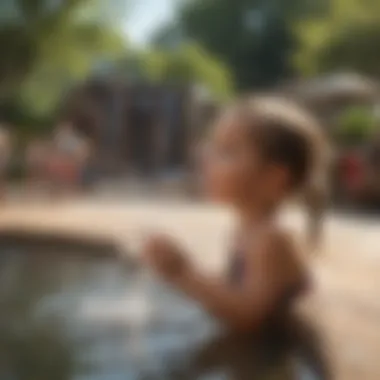Discovering Safari Splash at Fort Worth Zoo


Intro
Visiting the Safari Splash at the Fort Worth Zoo opens up a treasure trove of unique experiences. This interactive water feature is much more than just a place for a splash; it serves a vital role in wildlife education and conservation. By immersing visitors—particularly families and young children—in the world of animals and their habitats, Safari Splash is an educational haven that encourages appreciation for wildlife.
Fascinating Facts About the Animals
Safari Splash is home to a variety of unique creatures, each with captivating characteristics and behaviors that intrigue the visitors who come to learn and play.
Unique Characteristics
One of the remarkable highlights of Safari Splash is its array of animal inhabitants, some of which are quite rare. For instance, the Nile crocodile is often considered an apex predator in its environment with its powerful jaws. Its scaly skin offers both camouflage and protection, making it one of the most effective hunters in the animal kingdom. Another fascinating resident is the red river hog. This animal boasts striking features, like its tufted ears and vibrant coloration, setting it apart in the wild.
Extraordinary Abilities
Among the animals featured, abilities like the high-flying leaps of the African fish eagle are both stunning and essential for their survival in the wild. It has exceptional vision that allows it to spot fish from great heights. Additionally, the playful antics of otters delight visitors, showcasing their remarkable swimming and diving skills, which are crucial for their foraging habits. These unique traits not only educate families but spark the curiosity of visitors, prompting questions and discussions about wildlife.
Behavior and Habitat
The behaviors of animals often reflect their adaptations to their habitats, and at Safari Splash, these behaviors can be observed closely.
Natural Habitats
Each species at Safari Splash has a carefully designed environment that mimics its natural habitat. The lush vegetation around the ponds emulates wetlands in Africa, providing a glimpse into the ecosystems these animals thrive in. Understanding these habitats helps visitors grasp the delicate balance of nature and the importance of habitat conservation.
Social Structures
Many animals have interesting social structures. For instance, meerkats display a fascinating social dynamic, often seen standing as sentries to alert their group of approaching dangers. Learning about such social behaviors highlights the complexity of animal interactions and the importance of community in the wild.
Recent Scientific Discoveries
The world of wildlife education is constantly evolving, driven by new research and scientific discoveries.
Latest Research Findings
Recent studies have uncovered fascinating insights about animal behavior and physiology. For example, researchers have found that certain amphibians have developed unique adaptations to survive in changing climates, which can serve as indicators of environmental health. Engaging with these findings at Safari Splash encourages curiosity and a desire to learn more.
Breakthroughs in Animal Biology
Understanding animal biology aids in conservation efforts. Breakthroughs such as artificial breeding techniques for endangered species are part of ongoing discussions at wildlife education centers like the Fort Worth Zoo. These insights strengthen the need for conservation and highlight the zoo's role in safeguarding various species.
Cultural Significance
Animals often hold deep significance in various cultural contexts, which can enhance the educational experience at Safari Splash.
Animals in Folklore
Different cultures celebrate animals through folklore. For instance, in many African traditions, animals like the elephant symbolize strength and wisdom. Stories about these animals can impart lessons about respect and coexistence, resonating with visitors deeply.
Influence on Art and Literature
Additionally, animals have influenced art and literature for centuries, featuring prominently in painting, sculpture, and storytelling. The rich narratives often shared at Safari Splash can inspire creative thinking and foster appreciation for the artistry tied to wildlife.
"Wildlife serves not just as a backdrop but as a catalyst for deeper understanding, prompting us to reflect on our connection with nature."
By bringing together fascinating facts, ecological education, and cultural significance, Safari Splash truly enriches the experience of every visitor, making it an essential part of the Fort Worth Zoo's mission to promote both wildlife education and conservation. Through fun interactions and learning opportunities, the zoo helps nurture a profound appreciation for the world of animals.
Overview of Fort Worth Zoo
The Fort Worth Zoo holds a distinctive place in the landscape of wildlife conservation and education. This zoo isn't just a haven for animals; it serves as a vibrant educational arena where knowledge about species, habitats, and the importance of biodiversity is imparted to visitors of all ages.


Not only do visitors get to witness diverse animal species up close, but they also engage in conversations about wildlife preservation. The zoo's role extends beyond entertainment, focusing on scientific research and animal welfare. In that sense, the Fort Worth Zoo is a cornerstone for fostering a deeper understanding of our natural world and its myriad inhabitants.
Historical Context
Founded in 1909, the Fort Worth Zoo began its journey as a small collection of animals, but it has leaped into the modern era as a critical space for conservation. Over the last century, the zoo evolved alongside societal changes, adapting its missions and methods to prioritize wildlife protection. From its roots in a modest setting, today, it stands on 64 acres, home to over 500 species of animals.
In the mid-20th century, the Fort Worth Zoo embraced a more progressive view on animal care, moving away from traditional zoo concepts to focus on naturalistic exhibits. This shift has echoed through its current approaches to sustainability and education, aligning perfectly with modern standards in zoos around the globe. Embracing innovation and research, the zoo has not just survived but thrived, making it an influential player in wildlife conservation efforts.
Current Attractions
The Fort Worth Zoo is a feast for the eyes and the mind. Visitors can experience the lush landscapes of various ecosystems, showcasing everything from the African savanna to the South American rainforest. One of its standout features is the newly renovated exhibits that replicate animals' natural habitats, allowing visitors to understand their behaviors and needs better.
- Wildlife Conservancy: The zoo features hands-on educational programs that focus on endangered species. This adds another layer of experience for the visitors, who can participate and learn about conservation efforts firsthand.
- Interactive Areas: For families, interactive exhibits offer a chance to connect more deeply with the animal kingdom. From feeding sessions to walking through a butterfly garden, the zoo goes beyond the typical visit experience.
- Engaging Educational Programs: Workshops for children and adults alike delve into topics such as habitat preservation and wildlife rehabilitation, ensuring that every visit is both fun and educational.
"The Fort Worth Zoo not only showcases wildlife but educates the public, encouraging active participation in wildlife conservation."
In summary, the Fort Worth Zoo's historical depth and current attractions paint a picture of a hub dedicated to wildlife education and ecological awareness, making it an essential visit for families and wildlife enthusiasts. The zoo fosters connections between people and wildlife, underlining the idea that every creature plays a crucial role in our ecosystem.
Understanding Safari Splash
Safari Splash at Fort Worth Zoo is not just a collection of water features; it represents a thoughtfully crafted environment that parallels the essence of wildlife education and conservation. This space invites visitors to engage closely with elements inspired by natural ecosystems, fostering a sense of connection to the animal kingdom. Knowing the intricacies of this experience becomes essential for families, veterinarians, and wildlife enthusiasts alike, as it plays a crucial role in promoting an understanding of habitat preservation and species diversity.
Concept and Design
The design of Safari Splash emerges from a fusion of fun and functionality. Each feature is strategically placed to encourage exploration while educating visitors about the natural world. Waterfalls, pools, and interactive exhibits simulating different habitats not only serve as entertainment but also as a pedagogical tool. For example, the layout mirrors the flow of actual rivers, informing guests about the critical role aquatic ecosystems play in sustaining wildlife.
Visitors can observe various structures mimicking natural formations, which can resonate with wildlife biologists seeking to understand how animal behaviors adapt to different environments. The tactile experiences provided by the splash zones bridge the gap between observation and interaction—making nature accessible to all ages.
- Key Elements of Design:
- Interactive water features that allow children to splash and explore.
- Educational signage explaining the importance of each feature in its ecosystem.
- Shade structures that feature plants native to Texas, enhancing the immersive experience.
Ecological Relevance
The ecological significance of Safari Splash is profound. This area stands as a living example of conservation efforts, balancing entertainment with education. By creating spaces that mimic natural habitats, visitors gain insight into the delicate interplay of ecosystems. It's crucial for attendees to understand that each drop of water contributes to the survival of species ranging from the smallest insects to larger mammals.
"Connecting young minds with wildlife through thoughtful designs empowers a generation of conservationists."
Moreover, Safari Splash aligns with broader conservation efforts by promoting biodiversity. Understanding local flora and fauna encourages a commitment to preserving these elements in the wild. For instance, educational talks and scheduled activities provide opportunities for deep dives into species' relationships within ecosystems.
Attractions within Safari Splash
The Safari Splash area at Fort Worth Zoo stands as a vibrant venture not just in entertainment, but in facilitating connections between wildlife, education, and conservation efforts. Through myriad attractions, this portion of the zoo captivates visitors of all ages, making learning a dynamic experience. Each feature within this expanse comes with its own set of benefits and considerations that contribute to the overarching mission of engaging the public in wildlife appreciation and awareness.
Water Features
Water plays a crucial role in the Safari Splash experience. From gently flowing streams to splashing fountains, the water features are more than just visually appealing; they serve as focal points for both play and education. The sound of water trickling sets a soothing ambiance, while elements like spray jets provide moments of joy for the children, drawing them into an immersive environment.
Moreover, these features often mimic natural habitats. For instance, the design incorporates pools that reflect the ecosystems found across different continents where animals are native. Such creative representation not only enriches the guest experience, but also provides vital insights into habitat conservation.
"Water features at Safari Splash are a delightful blend of fun and learning, offering a unique way to engage with wildlife themes," says a wildlife educator.
Animal Interactions
One of the standout attractions within Safari Splash is the opportunity for visitors to interact with animals. These interactions are not random; they are thoughtfully crafted to foster understanding and empathy towards different species. Children and adults alike get the chance to encounter animals like the playful otters or curious penguins.
These opportunities extend beyond mere observation. At designated times, trained staff facilitate sessions that allow visitors to learn about individual animal behaviors, their roles in ecosystems, and how people can help protect their habitats. This hands-on approach encourages a personal connection to wildlife, which is essential for fostering a conservation-oriented mindset. Visitors often walk away with a greater awareness of their impact on natural environments, appreciating the intrinsic values of biodiversity.
Hands-On Learning Experiences


Learning at Safari Splash isn't confined to the classroom; it spills into interactive workshops and demonstrations. This emphasis on hands-on experiences allows families to dive deep into various topics, from water conservation to animal care.
Workshops often involve activities such as:
- Constructing miniature habitats
- Wildlife art using recycled materials
- Educational games that highlight local biodiversity
Such activities not only enhance understanding but also cultivate a sense of responsibility toward nature. By participating in these hands-on learning experiences, visitors grasp complex ecological concepts in engaging and memorable ways. They leave with practical knowledge that extends beyond their time at the zoo, prompting them to consider their roles in conservation efforts back home.
Educational Programs
Educational programs play a critical role in enhancing the experience offered at Safari Splash. They bridge the gap between wildlife observation and understanding, providing visitors with insights that extend beyond mere enjoyment. These initiatives foster a connection between the public and the natural world, encouraging sustainable practices and conservation efforts.
Workshops and Events
Workshops and events at Safari Splash are designed to engage participants of all ages. These programs often include hands-on activities that immerse visitors in the wonders of the aquatic ecosystem. For example, families can partake in water-themed science experiments where they learn about aquatic habitats and species diversity.
Many such events emphasize the significance of conservation through interactive learning. When children dive into educational games focused on the importance of maintaining a healthy ecosystem, they carry lessons that influence their perspective long after the event is over. It's a bright idea to use the lively, playful nature of Safari Splash to teach serious subjects like water conservation, wildlife protection, and environmental stewardship. In this setting, learning becomes not just an obligation but an adventure.
Collaborative Efforts with Schools
The collaboration between Safari Splash and local schools marks a fruitful partnership focused on educational outreach. These initiatives strive to integrate wildlife education into standard curricula. Classes often make the trip to Safari Splash for field trips, where instructors have crafted special programs aligned with educational standards. Such programs allow teachers to utilize real-life examples and experiences, creating a rich learning environment for students.
This cooperative effort not only benefits students but also helps teachers by providing resources and materials that can enrich classroom discussions. Moreover, schools benefit by nurturing an early appreciation of biodiversity and the importance of conservation in students, ensuring that the next generation grows into informed advocates for the environment.
Understanding various species, their habitats, and the role they play in the ecosystem nurtures empathy and respect. As children engage in lessons about aquatic life, they come to realize the challenges these creatures face, from habitat loss to pollution. Encouraging students to express their ideas, such as creating art inspired by their learnings, makes the educational experience more profound.
Education is not just about knowledge; it's about kindling the spark of curiosity that will drive future conservationists.
These workshops and collaborations showcase Safari Splash's commitment to educating visitors and promoting a culture of wildlife conservation rooted in community engagement. This not only enriches the visitor experience but also sets a solid foundation for future ecological stewardship.
Impact on Wildlife Conservation
The Fort Worth Zoo’s Safari Splash plays a pivotal role in promoting wildlife conservation through various approaches. This section looks closer at how this interactive experience not only entertains but also educates visitors about the importance of biodiversity and active participation in conservation efforts.
Promoting Biodiversity
Biodiversity is the foundation of healthy ecosystems, and Safari Splash emphasizes this in several ways. When visitors interact with the vibrant displays and exhibits, they gain insight into numerous species that inhabit similar environments. For example, the splash zone features species like flamingos and otters that are essential to their ecosystems.
The zoo often organizes informative talks, highlighting how every creature, no matter how small, contributes to the larger ecosystem. By demonstrating the interconnectedness of life, Safari Splash encourages individuals to appreciate the variety of wildlife and understand that every conservation effort counts.
It also serves as a breeding ground for awareness about endangered species. Educational signage and interactive features highlight the plight of such creatures, urging attendees to remain informed and engaged. The experience fosters a sense of responsibility among visitors, who leave with a renewed commitment to protecting wildlife in their own communities.
"The preservation of biodiversity is not just a responsibility; it’s a privilege for us to cherish and protect the world we share."
Community Involvement
Community engagement is at the heart of conservation efforts at Safari Splash. The zoo actively collaborates with local organizations, schools, and volunteers to spearhead conservation campaigns. These initiatives often include clean-up drives, tree planting, and wildlife monitoring projects. Through community involvement, Safari Splash encourages individuals to roll up their sleeves and take part in stewardship activities.
Additionally, the educational programs tailored for community groups underline the role individuals can play in wildlife preservation. Workshops, held regularly, inform families about sustainable practices they can adopt at home. Topics range from creating wildlife-friendly gardens to reducing plastic waste.
The presence of local schools cannot be overlooked either; Safari Splash regularly hosts field trips that allow students to engage directly with nature. Such experiences leave a lasting impression on young minds and ignite a passion for nature that often persists into adulthood.
Every effort made to involve the community builds a robust network of wildlife advocates, crucial for future conservation endeavors. It nurtures a culture of respect for wildlife, creating a ripple effect that is essential for long-term impact.
Visitor Insights
Understanding the perspectives of those who visit Safari Splash is crucial in grasping its impact and success. These insights provide valuable feedback on the effectiveness of attractions, educational programs, and the overall experience. Visitors often shape the narrative around the Zoo’s offerings, reflecting both appreciation and the areas needing attention.
Insights gathered from visitors can illuminate aspects that might not be immediately apparent to the zoo staff. They offer context to the experiences shared; sometimes even shining a light on elements that contribute positively or negatively to their visit. This engagement helps to foster a more inclusive environment by considering diverse user experiences.


Moreover, insights from visitors can stimulate discussions about wildlife education and conservation efforts. Parents, children, school groups, and zoological enthusiasts each have unique perspectives that enrich the understanding of the Safari Splash experience. Analyzing these insights can drive improvements and fine-tune offerings to better serve the community and fulfill the zoo's mission.
Experiences Shared by Attendees
Many attendees of Safari Splash express a blend of delight and inspiration. From families spending quality time together to school groups absorbing firsthand knowledge, the experiences shared often emphasize the interactive nature of the venue.
Visitors frequently mention the opportunity to engage with the environment. For instance, kids squeal with joy at the chance to splash around while learning about aquatic ecosystems. Parents often point out how easily children absorb information when they can connect it with play. Common sentiments shared include:
- Engaging with exhibits that promote physical activity and learning simultaneously.
- Hands-on experiences that allow children to explore nature's wonders.
- The soothing atmosphere created by the water features, which encourages relaxation amid educational pursuits.
Many comments reflect the value of the interaction between species, such as small workshops illustrating the relationship between different aquatic animals and their habitats. These lessons stick, and families leave with memories that they'll cherish and knowledge that stirs curiosity long after they’ve left.
Feedback on Facilities
Visitor feedback regarding the facilities at Safari Splash includes both commendations and constructive criticism. Many commend the cleanliness and accessibility of the attractions. Families especially appreciate the thoughtful consideration for both enthusiastic children and exhausted parents.
Positive points raised by visitors generally include:
- Ample shaded areas for relaxation, keeping families comfortable during their visit.
- Well-maintained restrooms and changing facilities, which is crucial for those with young children.
- Nearby food options that offer healthy choices, aligning with conservation messages.
Conversely, some concerns do arise. Issues typically highlight seasonal crowding during peak times, suggesting that a strategic approach to visitor management might be beneficial. Some visitors hope for more seating areas to accommodate larger groups, especially during educational programs or lunch breaks.
Feedback on facilities plays a pivotal role in shaping ongoing infrastructural improvements. Attuning to visitors’ suggestions allows the zoo to refine the experience, enhancing visitor satisfaction and fostering a deepened appreciation for wildlife conservation.
Challenges and Considerations
Exploring the intricate dynamics surrounding Safari Splash at Fort Worth Zoo calls for a close look at the challenges and considerations that shape its experience. Understanding these complexities is vital for ensuring the sustainability of this interactive feature while maintaining visitor satisfaction. This section elucidates several key elements that deserve attention, particularly environmental concerns and visitor management. Both of these factors intertwine to impact the ecological balance and visitor happiness at the zoo.
Environmental Concerns
The presence of water features, such as the inhaling mist of Safari Splash, truthfully adds to the charm but raises essential environmental questions. The balance needed to keep the ecosystem intact while providing engaging attractions is delicate. The construction of such interactive zones can disturb local habitats if not managed well. For example, factors such as water consumption and runoff can lead to issues.
- Water Usage: Proper resource management is critical. Water not only needs to be sourced sustainably but also treated to prevent contamination of local ecosystems.
- Habitat Disruption: While visitors enjoy watching animals play in simulated natural surroundings, it's crucial that any building or landscaping does not intrude upon existing wildlife habitats. Careful planning helps in mitigating this risk.
- Pollution Control: Maintaining cleanliness is important. Without stringent measures, pollutants can jeopardize water quality and impact both animal and plant life.
By prioritizing the environment and implementing best practices in water management, Fort Worth Zoo can continue to be a place where people appreciate wildlife without compromising the ecosystem's integrity. This management not only benefits the zoo but contributes to the greater cause of biodiversity preservation.
Visitor Management
Looking at the flow of guests through Safari Splash, it’s evident that visitor management is another core piece of the puzzle. Creating a comfortable and engaging experience for families while controlling crowds is a task filled with challenges. Optimal visitor management works to ensure everyone enjoys their time without feeling overwhelmed. Here are some approaches that can facilitate this effort:
- Timely Scheduling: Implementing timed entry slots helps spread visitor traffic effectively. This strategy alleviates overcrowding on busy weekends and holidays.
- Signage and Information Delivery: Clear directions and information boards guide visitors through the space. Engaging signage can direct attention to both the environmental elements of the splash pad and the animals.
- Staff Training: Having well-trained staff who can assist visitors and manage potential issues is essential. They serve as both guides and safety personnel, ensuring a pleasant experience for all.
"Understanding the intricate balance between man and nature lies at the heart of the visitor management strategy. Both must coexist for the beauty of places like Safari Splash to flourish."
These careful considerations do not merely enhance the visitor experience; they serve a more profound purpose in fostering a culture of respect for wildlife and the environment. As we continue to assess and improve these areas at Safari Splash, it spearheads the larger conversation on responsible recreation and conservation.
Future Prospects
The future of the Safari Splash area at Fort Worth Zoo holds significant promise, especially when viewed through the lenses of education and conservation. It’s a space that not only entertains but also fosters a crucial understanding of the natural world. Planning for future exhibits and features is essential as it allows the zoo to adapt to changing environmental challenges while enhancing visitor experiences. Expanding interactive offerings can bolster educational efforts, reaching diverse audiences better than ever. Crowds flocking to see the water features and animal interactions create a unique opportunity for learning, and ongoing development ensures that this engagement remains fresh and relevant.
Upcoming Exhibits and Features
As Fort Worth Zoo looks ahead, several exciting exhibits and features are on the horizon, presenting new ways for visitors to connect with wildlife. Potential upcoming installations might include:
- Expanded Aquatic Habitats: Creating larger, more immersive water exhibits that mirror natural environments. This approach should entice species that thrive in an aquatic setting, fostering an understanding of habitats and the importance of water conservation.
- Interactive Learning Stations: Incorporating technology into learning experiences, these stations could provide real-time data about the species present, such as diet, habitat, and conservation status.
- Seasonal Events: Seasonal celebrations could include themed educational weeks focusing on specific species or conservation efforts, allowing for a dynamic learning environment that changes throughout the year.
Ultimately, the goal is to create an environment that not only offers fun but also deepens knowledge and fosters a commitment to wildlife preservation.
Long-Term Goals for Conservation
The long-term conservation goals of the Safari Splash area go beyond immediate attractions. The zoo aims to:
- Promote Awareness: Continued efforts to raise awareness about endangered species and environmental challenges through educational programming. Informative signage around exhibits can spark conversations about conservation.
- Sustainability Initiatives: Implement sustainability practices within the zoo operations, such as water recycling and energy-efficient systems, demonstrating a commitment to environmental care.
- Collaboration with Conservation Organizations: Partnering with local and international wildlife conservation groups can help amplify the zoo's impact. By supporting field research and fostering on-the-ground conservation, Safari Splash can play a significant role in wildlife protection.
"As we look to the future, embracing educational innovation and conservation partnerships is crucial to ensuring that visitors not only enjoy their time here but also leave with a deeper understanding of our world and its challenges.”
By focusing on these goals, Safari Splash can ensure it evolves in alignment with global conservation movements while remaining a vibrant, educational, and enjoyable destination for visitors of all ages.







